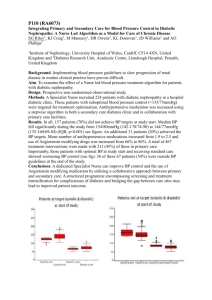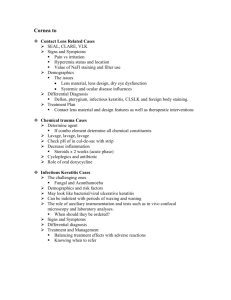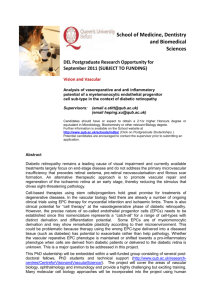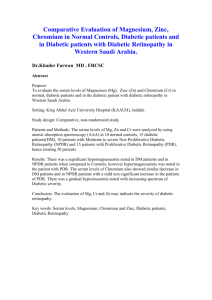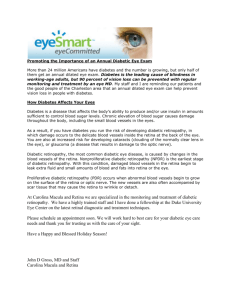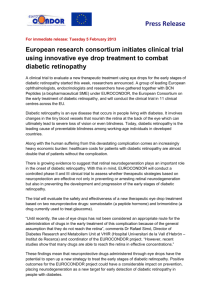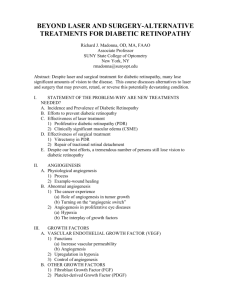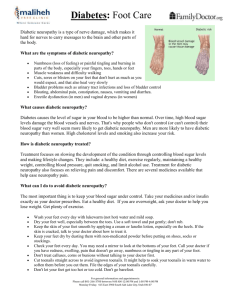Endocrinology 10a – Microvascular Complications of
advertisement
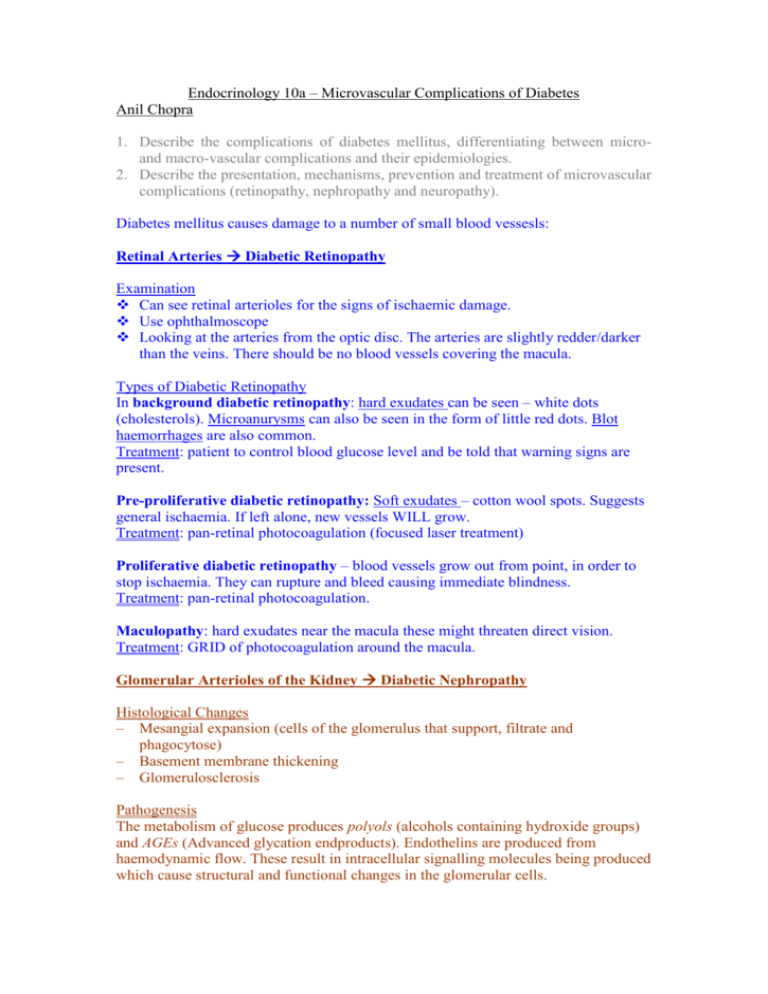
Endocrinology 10a – Microvascular Complications of Diabetes Anil Chopra 1. Describe the complications of diabetes mellitus, differentiating between microand macro-vascular complications and their epidemiologies. 2. Describe the presentation, mechanisms, prevention and treatment of microvascular complications (retinopathy, nephropathy and neuropathy). Diabetes mellitus causes damage to a number of small blood vessesls: Retinal Arteries Diabetic Retinopathy Examination Can see retinal arterioles for the signs of ischaemic damage. Use ophthalmoscope Looking at the arteries from the optic disc. The arteries are slightly redder/darker than the veins. There should be no blood vessels covering the macula. Types of Diabetic Retinopathy In background diabetic retinopathy: hard exudates can be seen – white dots (cholesterols). Microanurysms can also be seen in the form of little red dots. Blot haemorrhages are also common. Treatment: patient to control blood glucose level and be told that warning signs are present. Pre-proliferative diabetic retinopathy: Soft exudates – cotton wool spots. Suggests general ischaemia. If left alone, new vessels WILL grow. Treatment: pan-retinal photocoagulation (focused laser treatment) Proliferative diabetic retinopathy – blood vessels grow out from point, in order to stop ischaemia. They can rupture and bleed causing immediate blindness. Treatment: pan-retinal photocoagulation. Maculopathy: hard exudates near the macula these might threaten direct vision. Treatment: GRID of photocoagulation around the macula. Glomerular Arterioles of the Kidney Diabetic Nephropathy Histological Changes – Mesangial expansion (cells of the glomerulus that support, filtrate and phagocytose) – Basement membrane thickening – Glomerulosclerosis Pathogenesis The metabolism of glucose produces polyols (alcohols containing hydroxide groups) and AGEs (Advanced glycation endproducts). Endothelins are produced from haemodynamic flow. These result in intracellular signalling molecules being produced which cause structural and functional changes in the glomerular cells. Epidemiology • IDDM : 20-40% have diabetic nephropathy after 30-40 years • NIDDM : Probably equivalent but also racial and age factors may affect morbidity. Clinical Features Progressive proteinuria o Normal Range <30mg/24hrs o Microalbuminuric Range 30 - 300mg/24hrs o Assymptomatic Range 300 - 3000mg/24hrs o Nephrotic Range >3000mg/24hr Increased blood pressure o Diabetics lose dip in blood pressure as they sleep. i.e. their 24hr blood pressure is higher. Deranged renal function o End-stage renal failure could develop in 2-7 years. Treatment for Diabetic Nephropathy Diabetic control Blood pressure control Inhibition of the activity of RAS system o ACE inhibitors reduce proteinuria progression as well as cardiovascular morbidity. Stopping Smoking Low protein diets Aminoguanidide Aldos reductase inhibitors Lipid lowering therapy Breyer Vasa Nervorum (vessels supplying nerves) Diabetic Neuropathy The vessels supplying the nerves become blocked. The mechanism of blood vessel damage is unknown, but high levels of glucose may be converted by aldose reductase to sorbitol (a polyol). This along with glycation end products can cause blood vessel damage. There are a number of different types of neuropathy: Peripheral polyneuropathy Longest nerves supply the feet – therefore patients complain of loss of sensation in their feet, and do not sense injury to their foot. It is more common in taller people and patients with poor blood glucose control. o Patients tend also to lose ankle jerk. o Cannot feel vibration of tuning fork. o Multiple fractures (Charcot’s joints) are seen on X-ray Mononeuropathy Mononeuropathy is a sudden loss of motor function (wrist drop, foot drop); sensory loss is rare. It can result in cranial nerve palsy and cause double vision if this occurs in nerve III (oculomotor). IV and VI cranial nerve palsies can lead to down and out eye (with intact light reflex : as opposed to a space-occupying lesion that cause a fixed and dilated pupil with no response). The pupil reflex still occurs because the parasympathetic fibres are on the outside and do not lost blood supply in diabetes. If there is an aneurysm however, it may press on parasympathetic fibres of the 3rd cranial nerve first causing fixed dilated pupil. Mononeuritis multiplex This is a random combination of nerve lesions. Radiculopathy Characterised by pain over spinal nerves, usually affecting a dermatome on the abdomen or chest wall. Autonomic neuropathy Loss of sympathetic and parasympathetic nerves to GI tract, bladder, cardiovascular system. It can result in; - difficulty swallowing - delayed gastric emptying - constipation - nocturnal diahorroea - bladder dysfunction. - Postural hypotension - Disruption of autonomic supply to cardiac muscle. Diagnosed by looking at ECG and compare R-R intervals in response to the Valsalva manoeuvre (forced breathing out with nose and mouth held shut) There should normally be a change in hear rate. Diabetic amyotrophy It is an asymmtertrical painful proximal motor loss & and muscle wasting.



